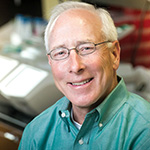 Professor Emeritus
Professor Emeritus
Research Areas
Developmental regulation of gene expression
Biography
Tim Townes graduated from the University of Tennessee in 1973 with a B.S. degree in Biology. He completed a M.S. degree in Biology in 1976 and a Ph.D. degree in Microbiology in 1980 from UT. After postdoctoral training in Biochemistry and Molecular Genetics at the University of Cincinnati School of Medicine, Tim accepted a faculty position in August of 1984 at the UAB School of Medicine in the Department of Biochemistry and Molecular Genetics. He was promoted to Full Professor in 1992 and served as Chairman of the Department of Biochemistry and Molecular Genetics from 2001-2016. He also founded the UAB Stem Cell Institute in 2010. The major research interest of Dr. Townes’ laboratory is the development of genetic therapies for blood disorders such as sickle cell disease and severe combined immunodeficiency. He has published over 90 peer-reviewed papers and has several issued patents. His most recent work establishes a foundation for the safe and effective correction of inherited and acquired blood disorders with a modified version of the CRISPR/Cas system. Dr. Townes is a frequent speaker at international conferences on gene regulation and gene therapy. In the past year, he has given invited lectures in Johannesburg, South Africa, San Francisco, California, Washington DC, Boston, Massachusetts and Seattle, Washington.
Research Interests
The major interest of my laboratory is the regulation of gene expression during development. We study the human hemoglobin genes as a model system and translate our understanding of basic mechanisms of globin gene regulation into strategies to correct hemoglobinopathies such as beta-thalassemia and sickle cell disease.
Our work focuses on the following 4 areas:
- Globin gene switching during development
- Locus Control Region regulation of chromatin structure and gene expression
- Genetic modifiers ofsickle cell disease severity
- Genetic therapies to correct sickle cell disease.
Our goals are to define the basic mechanisms that control globin gene regulation and to use these discoveries to develop novel strategies to cure hemoglobinopathies. Most of our studies involve the production of transgenic, knockout and knockin mice that enable us to define mechanisms of globin gene regulation and disease progression in vivo.
Some of the accomplishments of my graduate students, postdoctoral fellows and collaborators are as follows:
- the first transgenic mice that express a correctly regulated human gene [EMBO J., 4:1715 (1985)]
- the competition model of human hemoglobin switching during development [Genes and Development 4: 380 (1990)]; [TrendsIn Genetics 6: 219 (1990)]
- the first mice that express functional human hemoglobin A and S [Science, 245: 971 (1989)]; [Science, 247: 566 (1990)]
- the first knockout mouse model of beta-thalassemia [Proc. Natl. Acad. Sci.92: 9259 (1995)]
- thefirst mouse model of sickle cell disease [Science, 278: 873 (1997)]
- an early example of molecular memory in mammalian cells by reversible histone modification [Proc. Natl. Acad. Sci.97:377 (2000)]
- the first correction of a disease utilizing induced pluripotent stem cells (iPS cells) and the first demonstration of homologous recombination in iPSC (collaboration with Jacob Hanna and Rudolf Jaenisch at MIT) [Science 318:1920 (2007)]
- the first demonstration of a protein directly involved in the competitive switch from human fetal to adult hemoglobin [J. Biol. Chem. 270: 1955 (1995); Nat. Genet. 42: 742 (2010)].
- one of three groups demonstrating the production of functional T lymphocytes from induced Pluripotent Stem Cells (iPSC) derived from SCID patient skin biopsy [Cell Reports 12, 1668-1677(2015)]
- highly efficient and safe correction of the sickle mutation in iPSC with novel Adenoviral Vectors [Scientific Reports (Nature) 6:30422(2016)]
Most recently, we have produced a modified CRISPR/Cas9 complex that can be electroporated into primary hematopoietic stem cells and correct the sickle mutation with high efficiency. Compared with wild-type Cas9, our modified recombinant Cas9 proteins have low toxicity, high specificity and high efficiency. Transplantation studies of corrected CD34+ HSC/HSPC into NSG mice demonstrate high level correction in all cell lineages, and we have successfully cured our humanized mouse model of sickle cell disease.
Education
Graduate School
Ph.D., University of Tennessee, Knoxville
Postdoctoral Fellowship
University of Cincinnati School of Medicine
Contact
Office
Shelby Biomedical Research Building
Room 707
1825 University Blvd.
Birmingham, AL 35294-2182
Phone
(205) 934-5294
(205) 934-1963 (Lab)
Email
ttownes@uab.edu